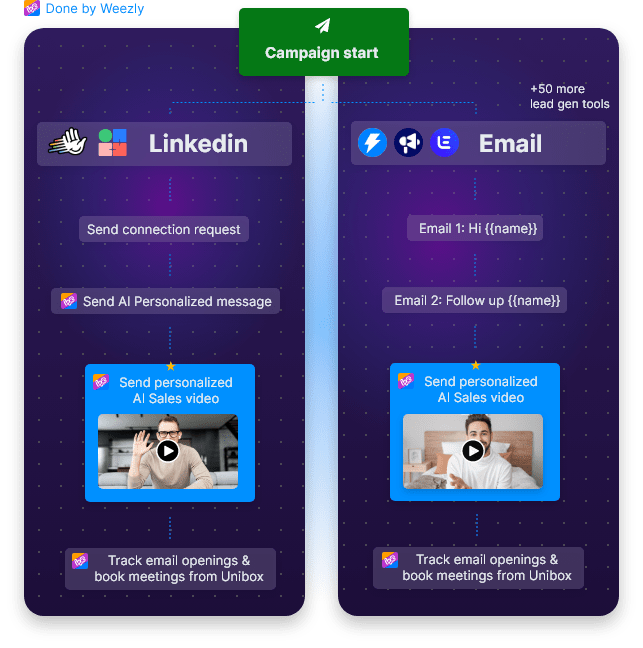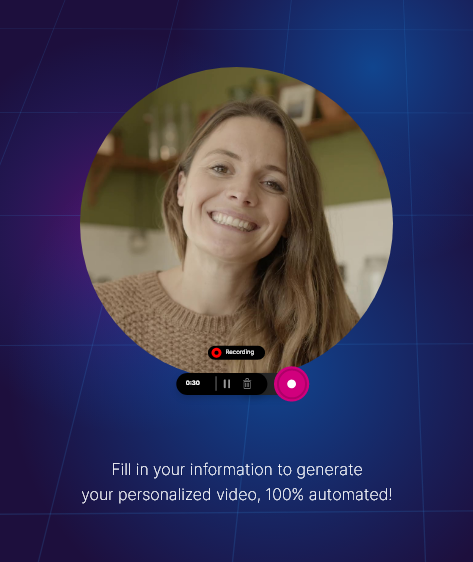In the fast-evolving landscape of digital marketing, sales prospecting has undergone a dramatic transformation. One of the most effective strategies to emerge in recent years is sales prospecting with video. With the rising importance of personalized engagement, video offers a unique and powerful way to connect with potential clients, building trust and fostering relationships in a way that traditional methods struggle to achieve.
In this detailed guide, we will explore the intricacies of sales prospecting with video, discussing why it works, how to implement it effectively, and how to leverage tools like Weezly to enhance your prospecting efforts. By the end of this article, you will be equipped with the knowledge and strategies to supercharge your sales prospecting in 2024.

The Power of Video in Sales Prospecting
Sales prospecting is all about making a connection. Traditional methods such as cold calls, emails, and text messages have their place, but they often lack the personal touch that today’s consumers crave. Video, on the other hand, provides a medium that combines visual and auditory elements, making your message more engaging and memorable.
Here’s why video is so powerful in sales prospecting:
- Humanizes the Interaction: Video allows you to put a face to your name, creating a personal connection that text-based communication cannot match. This is particularly important in sales, where trust and rapport are crucial.
- Increases Engagement: According to Wyzowl’s 2023 report, 96% of people have watched an explainer video to learn more about a product or service, and 88% say they’ve been convinced to buy a product or service by watching a brand’s video. Video content is naturally more engaging, leading to higher open rates and responses compared to traditional emails.
- Conveys Complex Information: Videos are excellent for breaking down complex ideas or products into easily digestible content. By using visuals, you can explain concepts more clearly and demonstrate products in a way that is both informative and compelling.
- Personalization at Scale: With modern video tools, you can personalize video messages for individual prospects without sacrificing time. This level of personalization shows that you value your prospects and have taken the time to understand their needs.
- Boosts Conversion Rates: Video has been shown to increase conversion rates significantly. A study by Vidyard revealed that personalized video messages can increase response rates by up to 4x compared to traditional outreach methods.
The Shift to Video: Industry Trends
The adoption of video in sales is not just a passing trend; it’s becoming a cornerstone of effective sales strategies. With remote work on the rise and digital interactions becoming the norm, businesses are increasingly turning to video to reach out to prospects. This shift is supported by data from HubSpot, which found that 59% of businesses are already using video in their sales outreach.
Additionally, platforms like LinkedIn have seen a surge in video content, with videos getting 20 times more shares than any other type of content on the platform. As buyers become more accustomed to consuming video content, sales teams must adapt to meet these expectations.
Implementing Video in Your Sales Prospecting Strategy
Step 1: Choose the Right Tools
To get started with video prospecting, you’ll need the right tools. There are several platforms designed specifically for creating, editing, and sending personalized video messages. Here are some of the most popular options:
- Weezly: Weezly is a versatile video creation tool tailored for sales teams. It allows you to easily create personalized video messages, track viewer engagement, and integrate with CRM systems. With Weezly, you can create videos quickly and efficiently, making it a valuable asset for any sales team looking to scale their video prospecting efforts.

- Vidyard: Another leading platform, Vidyard offers extensive features for video creation and analytics. It integrates seamlessly with various CRM tools, allowing you to track the performance of your videos and gain insights into how prospects are engaging with your content.
- Loom: Known for its simplicity, Loom is an excellent tool for creating quick video messages. It’s especially useful for recording screen shares, making it ideal for product demos or walkthroughs.
- BombBomb: BombBomb combines video creation with email marketing, allowing you to embed videos directly into your email outreach. This platform is particularly popular among real estate professionals but can be adapted for any industry.
Step 2: Create Engaging Content
Creating engaging video content is the cornerstone of successful video prospecting. Your video should be concise, personalized, and relevant to the prospect’s needs. Here’s how to achieve that:
Personalization
Start by addressing the prospect by name. This small detail makes a significant impact, showing that the video is tailored specifically for them. Mention something specific about their business or industry to demonstrate that you’ve done your research.
Conciseness
Keep your video short and to the point. Ideally, your prospecting video should be between 30 seconds to 1 minute long. In this time, introduce yourself, state the purpose of your outreach, and highlight the value you can provide.
Clear Call to Action (CTA)
Every prospecting video should have a clear CTA. Whether it’s scheduling a meeting, downloading a whitepaper, or visiting your website, make sure the next step is easy to follow.
Visual and Audio Quality
While you don’t need a Hollywood-level production, ensure that your video is clear and professional. Good lighting, clear audio, and a tidy background can make a big difference in how your video is perceived.
Step 3: Distribute Your Videos Effectively
Once your video is ready, it’s time to distribute it to your prospects. There are several ways to do this:
- Email: Embedding your video in an email is a powerful way to grab attention. Platforms like Weezly and BombBomb make it easy to embed videos directly into your email outreach. Ensure that your email subject line mentions the video, such as “Quick Video Just for You” or “Watch This Before Our Call.”
- Social Media: LinkedIn is a prime platform for video prospecting. You can send video messages directly to prospects via LinkedIn messages or post your video on your profile to attract inbound leads.
- CRM Integration: If you’re using a CRM like Salesforce or HubSpot, you can integrate your video tool to send personalized videos directly from your CRM. This allows for seamless tracking and follow-up.
- Landing Pages: Create personalized landing pages for your video content. This method is particularly effective for account-based marketing (ABM) campaigns where you can tailor the entire page to the specific prospect.
Step 4: Measure and Optimize
As with any sales strategy, it’s essential to measure the effectiveness of your video prospecting efforts. Most video platforms offer analytics that allow you to track key metrics such as:
- View Rate: The percentage of recipients who watched your video.
- Engagement Rate: How much of the video was watched by the viewer.
- Response Rate: The percentage of viewers who took the desired action after watching your video.
- Conversion Rate: The percentage of viewers who became customers after watching your video.
Use these metrics to refine your approach. If you notice that certain videos have higher engagement rates, analyze what makes them successful and apply those elements to future videos.
Best Practices for Video Prospecting
1. Tailor Your Message
The key to successful video prospecting is relevance. Tailor your message to the specific needs and pain points of each prospect. This requires research, but the effort will pay off in higher engagement and conversion rates.
2. Follow Up
Don’t rely on just one video. Follow up with additional content, whether it’s another video, an article, or a case study. This keeps the conversation going and shows that you’re committed to providing value.
3. Test and Iterate
Experiment with different video styles, lengths, and distribution methods. A/B testing can help you determine what works best for your audience. For instance, try varying your CTAs or testing different video thumbnails to see which generates more clicks.
4. Leverage Social Proof
Include customer testimonials or case studies in your videos to build credibility. Seeing how other companies have benefited from your product or service can be a powerful motivator for prospects.
5. Keep It Authentic
While it’s important to be professional, don’t be afraid to show your personality. Authenticity resonates with viewers and can make your video more relatable and trustworthy.
Overcoming Challenges in Video Prospecting
1. Time Constraints
Creating personalized videos can be time-consuming, especially if you’re targeting a large number of prospects. To overcome this, consider batching your video production. Record several videos in one sitting, then personalize each one with specific details relevant to the prospect.
2. Technical Difficulties
Not everyone is comfortable on camera or with the technical aspects of video creation. Practice makes perfect. Start with simple videos and gradually work your way up to more complex productions. Use tools like Weezly that offer intuitive interfaces and resources to help you get started.
3. Measuring ROI
It can be challenging to measure the direct impact of video prospecting on sales. To address this, use tracking tools to monitor engagement and conversions. Integrating your video platform with your CRM can also provide more comprehensive data on how video prospecting contributes to your sales pipeline.
The Future of Sales Prospecting with Video
As we move into 2024, the role of video in sales
prospecting is only expected to grow. Advances in technology, such as AI-driven video personalization and interactive video content, will further enhance the effectiveness of video prospecting.
Moreover, as younger, digital-native generations become decision-makers, the preference for video communication will likely increase. This makes it crucial for sales teams to adopt video prospecting now to stay ahead of the curve.
AI and Video Prospecting
Artificial intelligence is set to play a significant role in the future of video prospecting. AI-driven tools can help automate the video creation process, allowing for greater personalization at scale. For example, AI can analyze a prospect’s online behavior and tailor video content accordingly, making each interaction more relevant and timely.
Interactive Video Content
Interactive videos are another exciting development. These videos allow viewers to engage with the content directly, such as by clicking on different elements to learn more or by answering questions that guide the video’s narrative. This level of interactivity can significantly increase engagement and lead to higher conversion rates.
Conclusion: Embracing the Video Prospecting Revolution
Sales prospecting with video is not just a trend—it’s a powerful tool that can transform your sales strategy. By humanizing your outreach, increasing engagement, and delivering personalized content, video can help you connect with prospects in a meaningful way.
To succeed with video prospecting, it’s essential to choose the right tools, create engaging content, distribute your videos effectively, and continually measure and optimize your efforts. Platforms like Weezly are invaluable in this process, offering the features and flexibility needed to scale your video prospecting strategy.
As the digital landscape continues to evolve, embracing video prospecting will be crucial for staying competitive. By mastering this approach, you can position yourself as a forward-thinking, innovative sales professional ready to meet the demands of the modern market.









